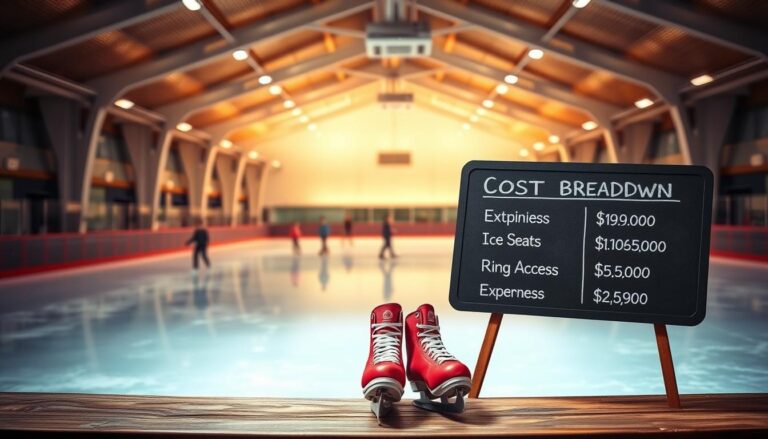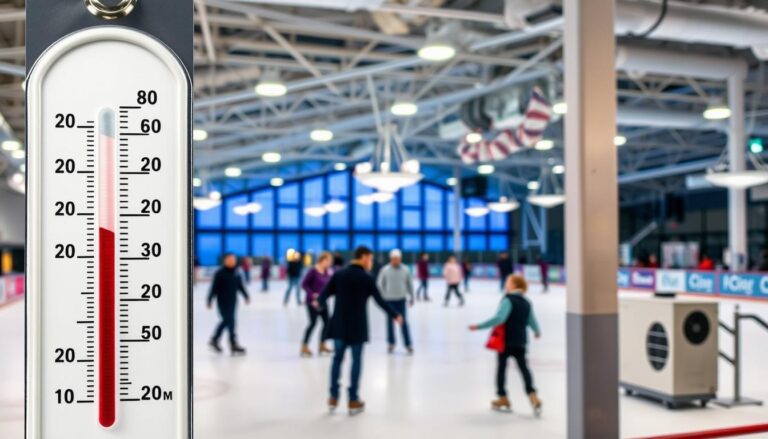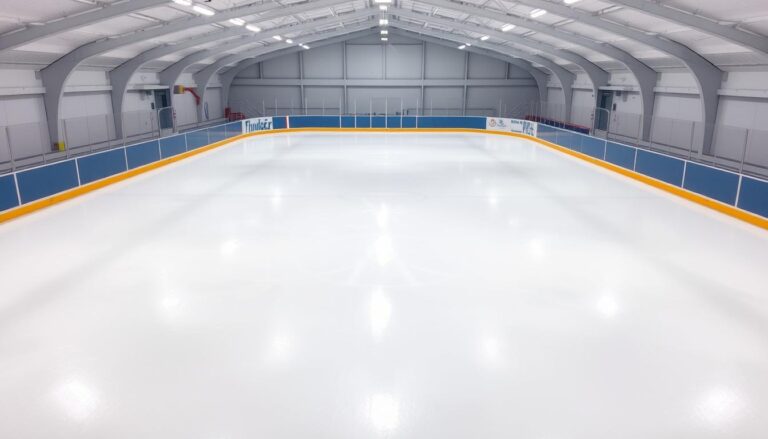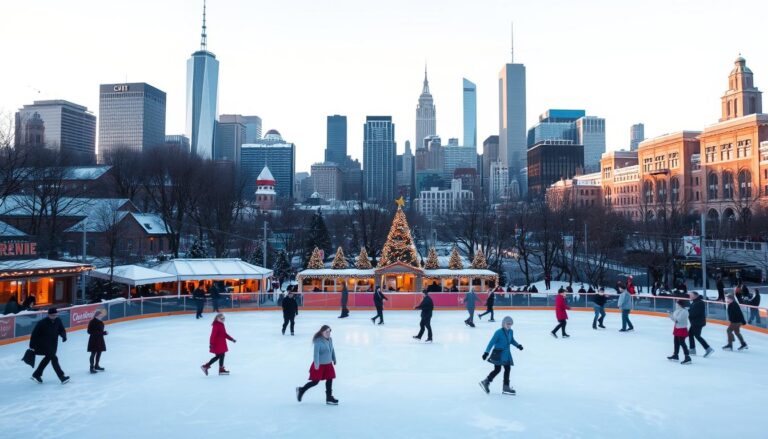Stop Ice Skating: Easy Steps to Safely Quit Skating
Ice skating is thrilling, but knowing how to stop is key. It’s important for both beginners and experts. Learning to stop safely makes you more confident on the ice.
For beginners, stopping can seem scary. It’s hard to control your speed and stop completely. But, with practice, you’ll learn to skate safely and with ease.
Stopping on ice is more than just avoiding crashes. It’s about mastering control and technique. There are many stopping methods, from simple to advanced, for every skill level.
This guide will teach you everything about stopping on ice. You’ll learn about ice skating physics, step-by-step techniques, and tips from pros. By the end, you’ll know how to stop smoothly and safely.
Safety is the top priority in ice skating. Learning to stop right is essential for avoiding accidents. It also helps you improve your skating skills with practice and patience.
Are you ready to improve your ice skating? Let’s explore stopping techniques that will make you glide with confidence. This guide covers everything from basic physics to advanced stopping methods. It’s your key to becoming a skilled and safe ice skater.
Understanding the Basics of Ice Skating Stops
Ice skating is more than just moving smoothly. Learning to stop safely and confidently is key. It makes your skating journey from nervous to enjoyable.
The science behind ice skating is interesting. You glide on a thin layer of water made by your skate’s pressure. This lets you move smoothly and stop well.
Physics Behind Ice Skating Movements
Knowing the physics of ice skating is important. Your weight, angle, and how you control your edges affect stopping. Key points include:
- Friction reduction through blade design
- Weight distribution across skating surfaces
- Momentum management
Different Types of Stopping Techniques
There are many ice skating techniques, depending on your skill and needs. Beginners start with the snowplow stop. More advanced skaters use hockey stops.
- Snowplow Stop: Ideal for beginners
- T-Stop: Intermediate technique
- Hockey Stop: Advanced method
Safety Considerations for Beginners
Always prioritize safety when learning to ice skate. Wear protective gear, practice in safe places, and progress slowly. Your confidence will grow with each practice.
Essential Equipment for Safe Stopping
Learning to stop on ice skates is more than just skill. It also needs the right gear. The right equipment makes stopping safer and more confident.
First, find the perfect pair of ice skates. Badly fitting skates can mess up your stopping. Look for skates that:
- Provide ankle support
- Have a comfortable, snug fit
- Include quality blades for precise stopping on ice skates
Protective gear is key when learning to stop. You’ll need:
- Helmet (protecting your head from falls)
- Knee pads
- Wrist guards
- Padded shorts for extra protection
Blade quality is also important for stopping. Sharp blades help you stop smoothly and precisely.
Getting top-notch equipment might cost more. But it’s worth it for learning to stop right and staying safe on the ice.
The Snowplow Stop: Your First Stopping Method
Learning to stop is key for beginner ice skaters. The snowplow stop is the first skill to master. It turns your skates into a natural brake, boosting your confidence on the ice.
To master the snowplow stop, you need to learn a few basics. This technique, named after its resemblance to a snow plow, is great for beginners. It helps you stay stable and in control.
Proper Body Position
Your body position is key for a good snowplow stop. Here’s how to do it right:
- Keep your knees slightly bent for better balance
- Maintain an upright torso with shoulders relaxed
- Look forward, not down at your skates
- Spread feet wider than shoulder-width apart
Weight Distribution Tips
Getting your weight right is important for a smooth stop. Try these tips:
- Shift your weight evenly between both feet
- Press inner edges of skates outward
- Apply gentle pressure to slow down
- Practice gradual weight transfer
Common Mistakes to Avoid
| Mistake | Correction |
|---|---|
| Stiff legs | Keep knees flexible and soft |
| Leaning backward | Maintain centered, upright posture |
| Sudden movements | Practice smooth, controlled motions |
Remember, every expert skater started exactly where you are now. Patience and practice will transform your skills on the ice.
How to Stop Ice Skating: Mastering the T-Stop
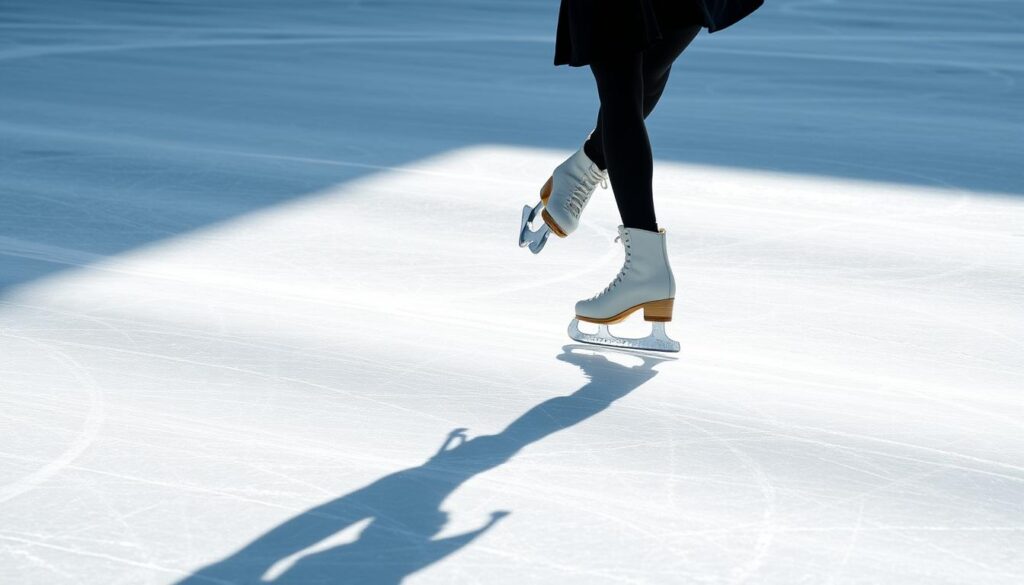
Learning to ice skate goes beyond the basic snowplow stop. The T-stop is a more advanced technique. It helps skaters control their speed and look stylish while stopping.
The T-stop works by placing one skate at a right angle to your path. This creates friction that slows you down. It’s a way to show off your skills on the ice.
- Start with proper body alignment
- Shift weight gradually
- Maintain balance during the stop
- Practice consistent blade angle
To do the T-stop right, your leading foot should be straight. The trailing foot slides at a 90-degree angle. It’s all about keeping your weight even and your core strong.
Here are some drills to help you get better:
- Begin on a flat, smooth surface
- Start with slow, controlled glides
- Gradually increase speed as confidence builds
- Focus on blade positioning
Experts say it’s important to spend time on the T-stop. Start with short distances and then try longer glides and faster speeds.
Building Confidence with Practice Drills
Learning to ice skate takes a lot of practice and smart learning methods. To become a confident skater, you need to build skills step by step and safely.
Improving your stopping skills means breaking down big movements into smaller ones. Beginners can turn their doubts into skills with specific drills. These drills help improve balance and control.
Simple Exercises to Boost Confidence
- Stationary balance practice on both feet
- Gliding short distances with controlled movements
- Weight shifting exercises on the ice
- Practicing stopping positions without moving
Progressive Learning Techniques
Ice skating tips for beginners focus on growing skills slowly. Start with basic techniques and add more complexity as you get more comfortable.
| Skill Level | Focus Area | Practice Duration |
|---|---|---|
| Beginner | Balance and Basic Stops | 15-20 minutes |
| Intermediate | Controlled Gliding | 30-45 minutes |
| Advanced | Complex Stopping Techniques | 45-60 minutes |
Remember, consistent practice is the key to becoming a confident ice skater. Each drill you complete brings you closer to mastering your skating skills.
Advanced Stopping Techniques for Experienced Skaters
Experienced ice skaters know that mastering advanced ice skating stops is key. These techniques go beyond basic braking. They require precision, control, and confidence.

Professional skaters turn braking into an art form with special techniques. Let’s look at some advanced methods to improve your skating:
- Hockey Stop: A dramatic lateral slide that brings you to an immediate halt
- Power Slide: A dynamic stopping technique used in competitive skating
- Pivot Stop: A controlled rotation that demonstrates exceptional edge control
Each advanced ice skating stop needs specific muscle engagement and technical precision. Skaters must develop:
- Strong core muscles
- Exceptional balance
- Precise edge control
- Mental focus and confidence
Safety is key when learning these advanced techniques. Practice in controlled environments with proper gear. Consider professional instruction to perfect your approach.
| Stopping Technique | Difficulty Level | Skill Requirements |
|---|---|---|
| Hockey Stop | Advanced | Strong leg muscles, edge control |
| Power Slide | Expert | Balance, flexibility, core strength |
| Pivot Stop | Advanced | Precise edge control, rotation skills |
Dedicated practice makes challenging ice skating stops smooth and controlled. It shows off your skating skills.
Common Mistakes When Learning to Stop
Learning to stop on ice can be tough for new skaters. Even experienced skaters find stopping hard. It takes patience, practice, and knowing common mistakes.
Beginners often make mistakes that can be dangerous. Knowing these mistakes is the first step to getting better at ice skating.
Balance Challenges Every Skater Faces
Many skaters struggle with balance when stopping. The main issues are:
- Unstable body positioning
- Incorrect weight distribution
- Tension in leg muscles
- Fear of falling
Correcting Poor Skating Form
Good form is key when stopping. Here are important corrections to make:
- Align your body center – Keep your shoulders squared and knees slightly bent
- Practice weight transfer smoothly
- Maintain a relaxed upper body
- Focus on controlled movements
Skating pros say to fix these mistakes with practice and muscle memory. By fixing these basics, skaters can feel more confident and stop better.
Safety Precautions While Learning to Stop
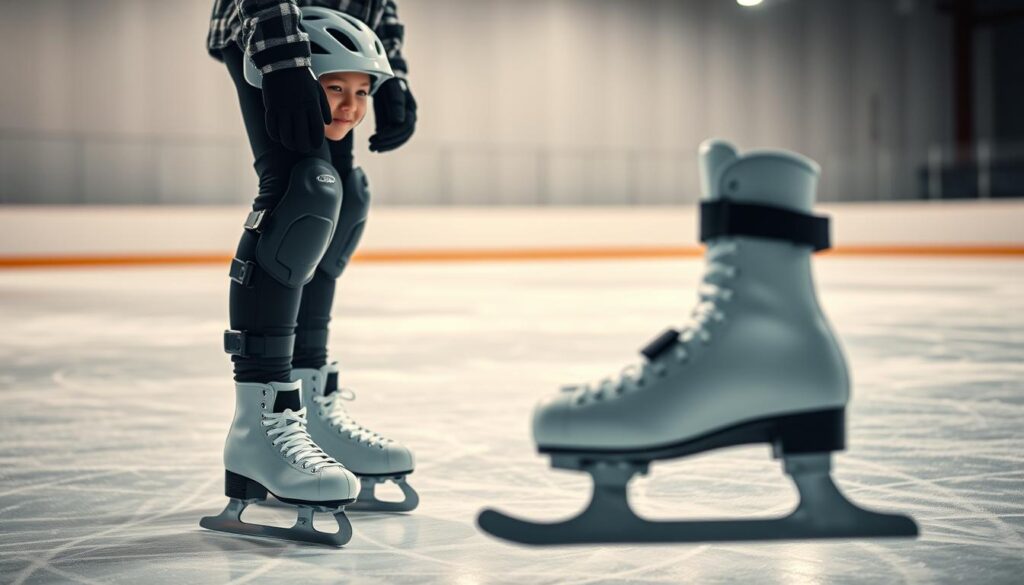
Learning to stop on ice skates is more than just mastering moves. Safety is key for beginners. The right protective steps can boost your confidence and keep you safe from injuries.
Before hitting the ice, make sure you have the right safety gear. Your protective equipment is your ally while you learn.
- Wear a well-fitted helmet to protect your head
- Use wrist guards to prevent fractures during falls
- Choose padded shorts or hip protectors
- Select thick, comfortable gloves
- Wear thick socks to prevent blisters
Proper warm-up exercises are vital for beginners. Stretch and do light exercises off the ice to get ready. This reduces muscle strains and boosts flexibility.
Start practicing stopping in a safe area of the rink. Look for less crowded spots and stay alert to others. Always keep a safe distance from people and things.
Pro tip: Learn to fall safely by practicing controlled falls on soft surfaces before attempting them on ice. Bend your knees, keep your arms close to your body, and try to slide instead of landing stiff.
Know your limits and progress slowly. Avoid pushing yourself too hard, too fast. Steady, careful practice will help you master safe stopping techniques.
Developing Muscle Memory for Effective Stops
Mastering ice skating techniques is more than just ice time. It’s about building muscle memory for smooth stops. Your body must learn the right moves through specific training.
Turning stops into natural movements takes off-ice and on-ice training. The aim is to make stopping feel easy and instinctive.
Training Exercises Off the Ice
Get ready for perfect stops with these exercises:
- Balance board training to improve stability
- Squats to strengthen leg muscles used in stopping
- Single-leg standing exercises for core strength
- Lateral jumps to enhance quick directional changes
On-Ice Practice Routines
Structured practice is vital for muscle memory in ice skating. Start slow and then speed up.
- Begin with static stopping positions
- Practice slow-speed stops
- Gradually increase stopping speed
- Integrate stops into different skating patterns
Pro tip: Consistency is key. Aim for short, focused practice sessions.
With time and effort, stopping will become automatic. Remember, muscle memory grows with repetition and practice.
Transitioning Between Different Stopping Methods
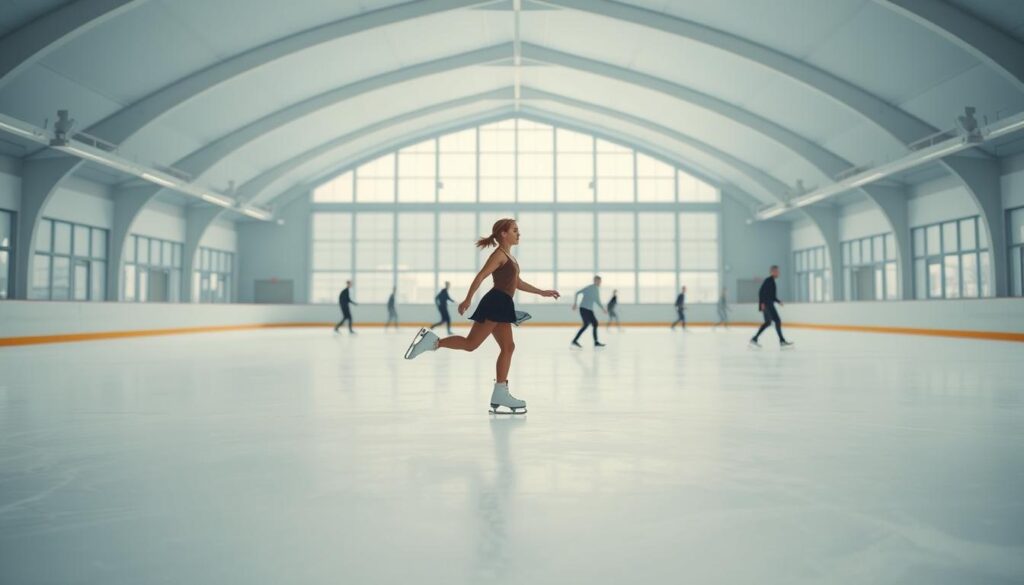
Learning ice skating stops is more than just knowing a few tricks. It’s about smoothly moving between different stops based on your speed and where you are on the ice.
Skaters who are good at this know it’s not just about knowing how to stop. It’s about being able to change your stop quickly. This can make all the difference between stopping smoothly or falling over.
- Assess your current speed
- Choose the most appropriate stopping technique
- Practice smooth weight transfers
- Develop spatial awareness on the ice
Getting better means practicing different stops together. The snowplow stop is good for slower speeds. The T-stop is better for faster speeds.
| Stopping Method | Best Speed Range | Difficulty Level |
|---|---|---|
| Snowplow Stop | Low to Medium | Beginner |
| T-Stop | Medium to High | Intermediate |
| Hockey Stop | High Speed | Advanced |
Getting good at changing stops takes practice. Start slow and then get faster and more complex.
Pro tip: Always maintain a balanced stance and keep your core engaged when switching between different stopping techniques.
Troubleshooting Your Stopping Technique
Mastering ice skating stops can be tough, but knowing common problems helps a lot. Learning to stop on ice takes patience and practice. Every skater faces obstacles that make stopping hard or unpredictable.
Skaters often face two big challenges: controlling speed and staying balanced. These tips will help you overcome these hurdles and feel more confident on the ice.
Identifying Speed Control Problems
Managing speed is key for safe and effective stops. Skaters often struggle with:
- Unexpected acceleration
- Difficulty reducing momentum
- Inconsistent braking
Practical Balance Adjustment Strategies
Staying stable while stopping needs special techniques. Here are some tips:
- Center your weight over skating blades
- Keep knees slightly bent
- Practice weight distribution drills
| Problem | Solution | Difficulty Level |
|---|---|---|
| Skidding During Stop | Adjust ankle angle | Beginner |
| Losing Balance | Strengthen core muscles | Intermediate |
| Inconsistent Stops | Practice specific stopping drills | Advanced |
Remember, every challenge is an opportunity to refine your skating technique. Stay patient and persistent in your learning journey.
Professional Tips from Skating Instructors
Professional ice skating instructors share a lot of knowledge on stopping techniques. They go beyond basic instructions, giving detailed tips that can really improve your skating.
Top skating pros say it’s all about strategy and mental prep. They stress the importance of visualizing your stops. This helps a lot in mastering the skill.
- Practice mental imagery before attempting complex stops
- Focus on body alignment and weight distribution
- Develop muscle memory through consistent repetition
- Study professional skaters’ techniques through video analysis
Experts share some key tips for better stopping skills:
- Build confidence through gradual progression
- Break down complex stopping techniques into smaller, manageable steps
- Use off-ice training to enhance muscle strength and control
Skating pros say mastering techniques takes time and practice. They advise adding stopping drills to every session. See them as key exercises, not just fun activities.
Recording your practice can help you see your progress. It lets you spot small improvements and track your growth over time.
Conclusion
Learning to stop on ice is key for any beginner skater. It’s not just about mastering moves; it’s about gaining confidence. It’s about enjoying a fun winter sport.
Every stopping technique you learn adds to your skills. It’s all about practicing and being patient. Remember, even pro skaters started as beginners, eager to learn.
Keep improving your skating skills. Try new things, stay safe, and have fun. Skating is more than just stopping; it’s about feeling free on the ice.
Your ice skating journey is just starting. Keep exploring and learning. Don’t be afraid to ask for help from experts. The ice is waiting for you to show off your skills!

